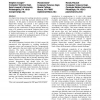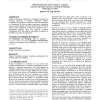1025 search results - page 17 / 205 » A vision for information visualization in information scienc... |
NIPS
1992
13 years 8 months ago
1992
In visual processing the ability to deal with missing and noisy information is crucial. Occlusions and unreliable feature detectors often lead to situations where little or no dir...
CHI
2004
ACM
14 years 8 months ago
2004
ACM
Speech interfaces should have a capability of dealing with inexplicit utterances including such as ellipsis and deixis since they are common phenomena in our daily conversation. T...
ROMAN
2007
IEEE
14 years 1 months ago
2007
IEEE
— For a robot to understand a scene, we have to infer and extract meaningful information from vision sensor data. Since scene understanding consists in recognizing several visual...
SIGCSE
2003
ACM
14 years 24 days ago
2003
ACM
An objects-first strategy for teaching introductory computer science courses is receiving increased attention from CS educators. In this paper, we discuss the challenge of the obj...
ITICSE
2006
ACM
14 years 1 months ago
2006
ACM
Adaptive explanatory visualization is an attempt to integrate two promising approaches to program visualization: adaptive visualization and explanatory visualization. The goal of ...


